

 |
 |
I was in the mood for a serious photo shoot, here in UK/Ireland we have just had our best Spring and Summer for years and much to our amazement this fine weather has continued into the start of Autumn. As I write this report now in early October I have just heard the Met Office announce that September 2014 has been the driest since records began in 1910 which is very impressive indeed. However, as much as I have enjoyed months of warm temps and sunny days there wasn't as much to celebrate regarding night sky records. Proper clear nights have been very few and far between thanks to high pressure associated low cloud, haze, mist and fog which had obscured all but the brightest of stars, then just as I was praying for the Atlantic to break through and clean the atmospheric muck away my prayers were answered, however I must not have been clear enough with my wishes because when low pressure did arrive it did the complete opposite and introduced more cloud due to slow moving warm fronts. After a great deal of patience and careful watching of the weather models an opportunity suddenly announced itself in the form of Friday September 27th when it looked like decent clear spells were possible and I wondered that morning if I could use this opportunity to try more star trails, I also wondered if my photography mate Paul Martin would be interested in a shoot too.
If you have read my reports before then you will know that Paul and I seem to be able to read each other's minds as we often come up with the very same idea independently of one other, so I wasn't surprised when I got a private message from Paul on facebook on Friday afternoon addressing the possible clear night ahead and if I would be interested in a photo shoot!. Messages were swapped as we discussed the cloud situation however inside I was quietly thinking that it would be great to do a photo shoot at Fanad Head lighthouse in Co. Donegal, amazingly it wasn't long before Paul suggested the very same thing, I just laughed in my mind because this stuff seems to happen so much now that it no longer shocks me. I was delighted that Paul was thinking along those same lines because although meeting up to shoot something locally was exciting enough the prospect of going to a distant and famous location was just too thrilling to ignore so we began discussing the logistics of how we would go about it. We had talked for months about doing a photo shoot at Fanad Head lighthouse and during that time many hours were spent on the internet reading about its history and admiring the breathtaking daylight images on the tourist websites, it was quite likely one of the most beautiful lighthouses in Ireland if not THE most beautiful. Perched as it was on a cliff overlooking the vast Atlantic Ocean it would be perfect for night sky photography and because of its location far away from any significant light pollution on the NW coast it would be an extremely dark location, the thought of it got me psyched up and there was no question that there was nowhere else Paul wanted to be too.
We were up for the location however could we justify the drive?, what if the clouds closed in?. Last week I had purchased a new car - actually a van - a band new Citroen Berlingo Enterprise all in black (of course) designed for low fuel costs and reliability which would be great for my kind of photography and although I had already done my first night photo shoot in this new van at Cargin chapel on the Staffordstown road I was hoping to do my first 'serious' photo shoot to break in the Berlingo and set the scene for many years of sky action and happiness ahead so a lot was riding on this adventure. I watched the television weather forecast and was shocked and disappointed to see that clouds were forecast over the west coast by 22.00 which meant that it was useless to even think about leaving and after some vernacular we almost had to call off the shoot entirely until we decided to study the forecast ourselves and make our own decision, after all, we obsess over charts in the Spring and Summer to chase storms so we just applied those same techniques to avoid cloud in search of clear skies. Well after studying the models and sat24 images I couldn't have disagreed more with the television forecast, it was clear here all day and it looked to stay clear for much of the night and although there were scattered clumps of cloud over the ocean heading for land there was nothing serious to worry about, there was a weather front hundreds of miles off-shore to our west - which was due to hit the following day - that front didn't have any high cloud ahead of it at all, in fact, it was very sharply defined and the precip models only showed rain hitting the SW coast by the morning so it was game-on, the decision was made, arrangements were sorted out and the adrenaline began to pump.
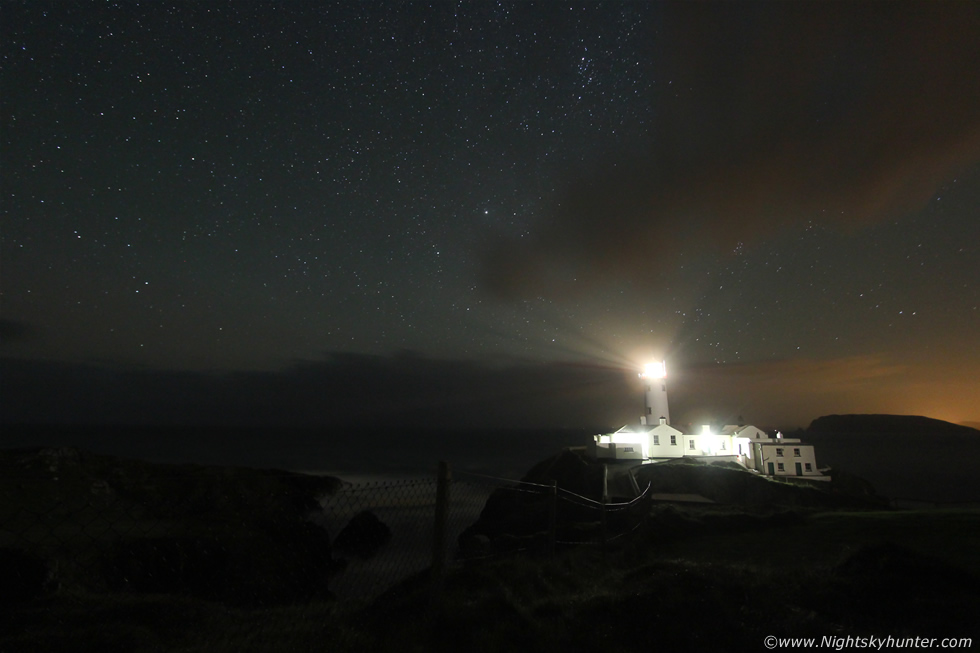 |
I picked up my partner Roisin Laverty at 19.30 then Paul arrived at my house at 20.00 then we quickly packed all our gear into the back of the Berlingo then all three of us got in the front, although there are three seats in the front it was far from roomy (two is great) so we felt a little crammed in however we didn't care in the slightest because we were on the road heading to a brand new location with the prospect of exciting photography ahead. We had flasks packed then made a quick stop for snacks at a filling station outside Dungiven then headed west under the moody blue half light of dusk, once we passed through Derry/Londonderry we headed N into - what was for me - unknown territory. The stars were visible through the window with no clouds in sight and we chatted about the odds of getting an aurora too, for even though nothing major was happening we had noticed before we left that the auroral oval was large and healthy in appearance associated with the interaction of a gentle solar wind stream with our own planet's magnetosphere which was stirring up activity to the far north however we knew from experience that there was a chance that something could be detected along the ocean horizon so it was good to know there was something else cooking.
We cut through Letterkenny into dark countryside as the van left the main road and entered the narrow twisting roads which snaked through the night towards the coast and after a two hour drive we suddenly arrived at our destination at Fanad Head, it was cool to know that with the exception of Malin Head we couldn't have been more further north, that's even more so than my old favourite locations along the Co. Antrim coast. As soon as I stepped out from the Berlingo and looked up I said ''wow'', I was immediately blown away by the sky, it was incredibly dark and quite possibly the darkest sky I have encountered this year to date, there were clouds visible however I could only tell there were clouds because there were dark regions with no stars visible, that's always a great sign and even before I could get dark adapted the Milky Way (MW) seemed to blaze across the sky with such brilliance I almost walked into the back of the van. We got the gear sorted then the three of us made our way along the coastline towards a large white pulsing light then finally we arrived at the front of the lighthouse. We didn't know where to look first or where to shoot, the MW was awesome behind us proudly stealing the show as it rose vertically from the southern horizon above the lighthouse keeper's supply buildings then extending vertically across the zenith before diving down into the NW sky behind the lighthouse then vanishing into the ocean. This was our first view of the lighthouse facing NW including airglow with Auriga, Perseus and the Pleiades rising behind the tower. We set up our gear beside the helicopter landing pad which became our base then Roisin kindly made us all a cup of much needed tea and snacks then after a period of MW shooting we made our way closer to the lighthouse, it was time to explore and do some serious photography.
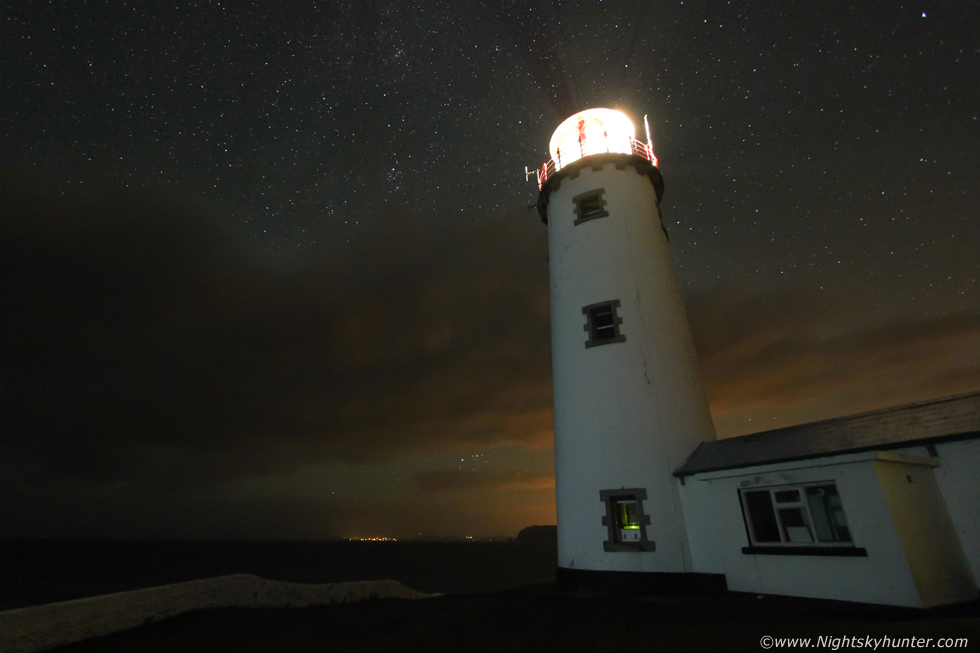 |
We where on the grounds close to the unmanned lighthouse and up close and personal with this wonderful white building, I found this angle I liked with the 10mm lens attached and began taking exposures, however the clouds were rushing in and the sky was turning overcast so I wanted to get a few captures just in case it closed in for the night. Within min's we lost all the stars in the sky and for a moment we verbally expressed our concerns that this could be it for the night, however we stayed positive and had faith that our instincts and the satellite images were correct and that it would clear again soon. We used the down time to relax and have another warm brew with yet more snacks, they were not necessary and I confess to being to greedy but my justification was that I needed energy for the session ahead.
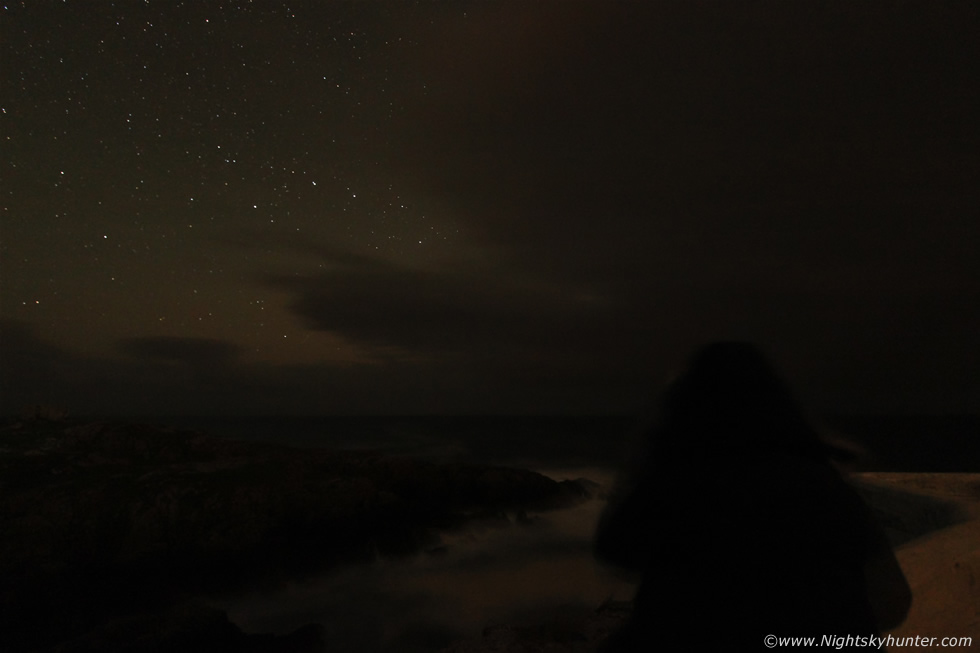 |
Clear breaks once again appeared from the west and we were back in action. I took this exposure of Roisin standing at the wall overlooking the ocean, if only you can appreciate how dark this was, even this exposure looks dark yet had I used the same exposure length anywhere else the detail would have been more obvious than it seems here - this is astronomer friendly countryside. When 100% clear skies arrived - and stayed - we felt like we were in heaven, I have never seen airglow so clear in all my life, airglow is the visible emission of light from the Earth's atmosphere and can only be observed visually from good dark locations combined with high quality transparency, to my eyes it looked like a vast area of green glowing in the form of a diffuse but uniform veil across the stars, it can sometimes be confused with the aurora however airglow is easily identified on camera, I have to say this was the best view of airglow I had ever seen in my life up to this point and I've done 19 years of astronomical observing from various dark inland and coastal locations previous to this so this sight in itself made the trip worth it.
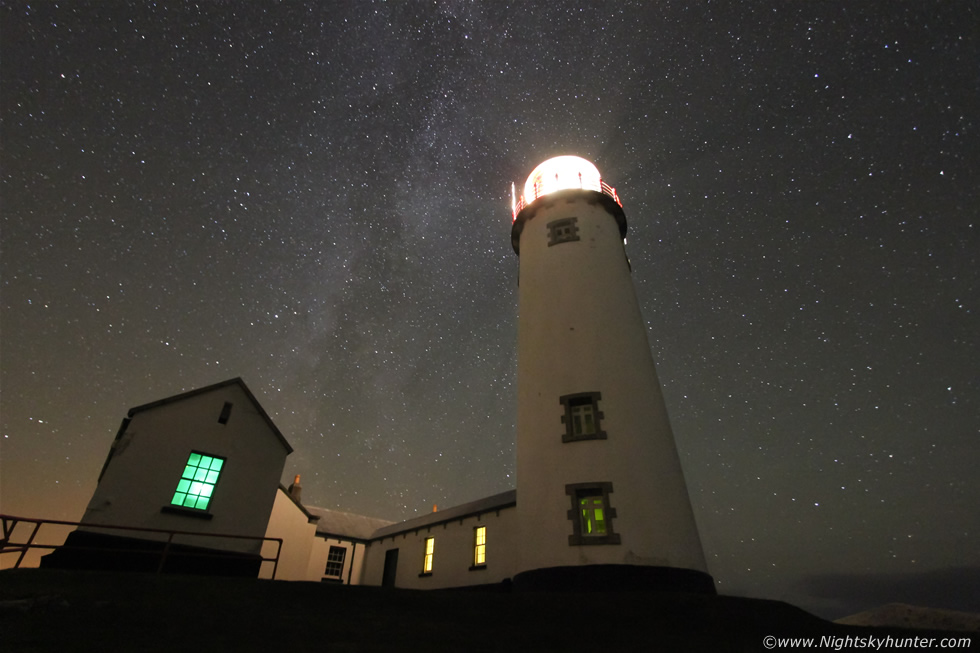 |
This was the middle of the night under superb clear skies. Roisin was relaxing on a chair while gazing peacefully at the MW and stars while Paul and I were busy doing photography. At times we would be shooting a certain angle together however for the majority of the time we were doing our own thing and following our instincts, Paul was around the corner somewhere on the opposite side, the dark form of a figure against the starry background was the only sign that Paul was there. All these are 10mm ultra wide angle on my x1.6 crop sensor Canon 600D, I normally don't shoot above ISO1600 at all due to noise issues however on this occasion I made an exception and used ISO3200 because for the first time in the 10 months since I got this camera I felt this location demanded the higher sensitivity This is the ISO3200 exposure with noise reduction applied so I just got away with it, the MW looked stunning in the form of two streamers crossing the sky from the left of the lighthouse and exiting the frame at the zenith with vivid dark dust lanes and absorption nebulae, clusters and emission nebulae.
I could see the North America Nebula (NAN) easily with the naked eye and had I thought to look I'm sure the Gegenschein was also on view, check out the 'Coat Hanger' asterism jumping out of the dark dusk lane between the lighthouse and building. On view from bottom to top along the centre of the image is Scutum, Aquila, Delphinus, Sagitta and Cygnus while to the lower right of the lighthouse (above the dark cloud) can be seen Corona Borealis 'The Northern Crown'. Experienced observers will note that the star RCrB is not visible on the image, RCrB is a cataclysmic variable star that can change its brightness at unexpected and unknown intervals however unlike other variable stars which can suddenly brighten RCrB actually fades from view, when behaving itself this star can be seen with the naked eye at mag +6.0 or slightly brighter, I have observed it every clear night since I got into astronomy and see it as an old friend, however all that changed years ago when it suddenly faded and now it cannot be seen with the naked eye or even on this long exposure image which is a truly amazing thought, theories suggest that this star erupts then surrounds itself with a carbon-like atmosphere which effectively shuts off its light like a blanket of soot, imagine living on a planet around that sun!. All of these stellar wonders are embedded within green airglow and it's moments like this that I wish I had a faster wide angle lens, the 10mm F/3.5 is a great general purpose lens however it is lacking when it comes to night work, with that said my next addition to the gear will be the Tokina 11-14mm F/2.8, however in the meantime the Canon 10mm is my work horse lens and it was far from letting me down this night.
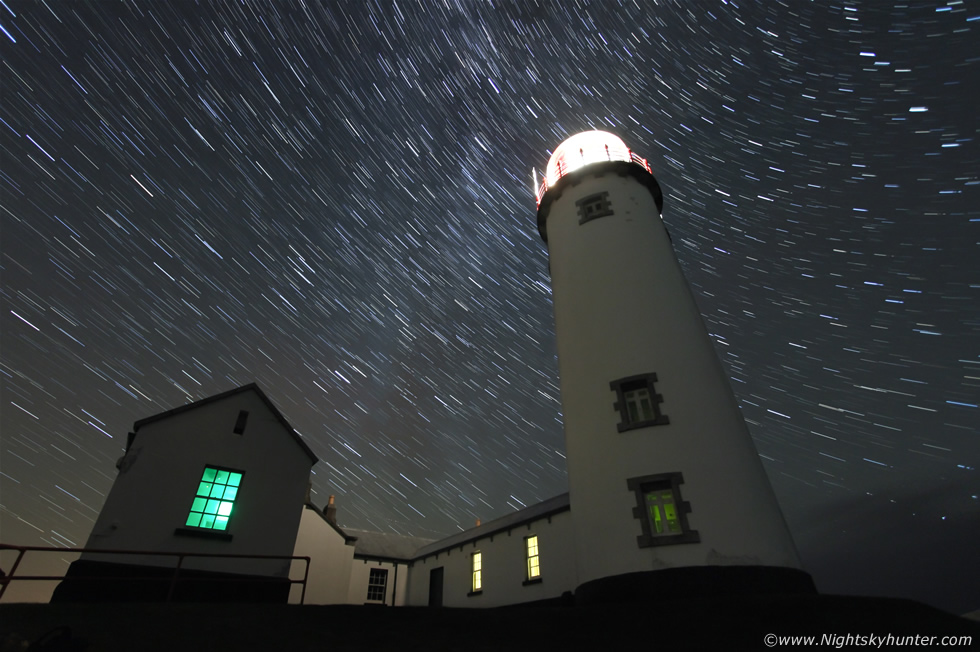 |
Same scene only this time I was in full star trail mode, a good visual check confirmed that the sky was 100% clear all around which was a luxury rarely witnessed of late so I took full advantage of nature's kind offering. This was 10mm at ISO1600 with 18 x 30 sec exposures or 9 min's of actual time. This was possibly my favourite image of the night however I wouldn't know what it would end up like until I was home when I could make the star trails on the lap top, this adds to the excitement of this kind of night landscape photography, even on location while shooting the trails your imagination wonders what the final result will be like while you battle with anxiety in the hope that clouds don't arrive to end the shoot, but once at home it's a satisfying experience to watch all those images you took stack one on top of the other in real time on the screen, there's something brilliant about this process.
Why do the stars look like this?, is this a photoshopped image? - for those who don't know there is no photoshop involved here, as the Earth rotates during the night the stars will rise in the east, cross the meridian then set in the west and they do this surprisingly quickly, if you are observing for a few hours you will notice the change in their position however if you look through a telescope you will see the stars crossing the FOV in less than a min or so in a standard wide angle eyepiece, each star has its own 'sidereal rate' depending on its RA and DEC or latitude and longitude on the celestial sphere. Back in the days of film SLR cameras the shutter was locked open for hours on end then when developed the movement of these stars were recorded as trails. Since modern DSLRs are digital they tend to build up significant heat and hence noise which can destroy long exposure images so the best solution is to take shorter exposures - say 30 sec's - one after the other with the mirror locked up and shutter locked open using a cable release for as along as you want. Then you download the images onto your computer and use free online software - I use startrails.de - to stack the images together with a dark frame and get your final noise-free star trail. It's good fun however this kind of photography requires long clear skies, interesting foreground and an abundance of patience.
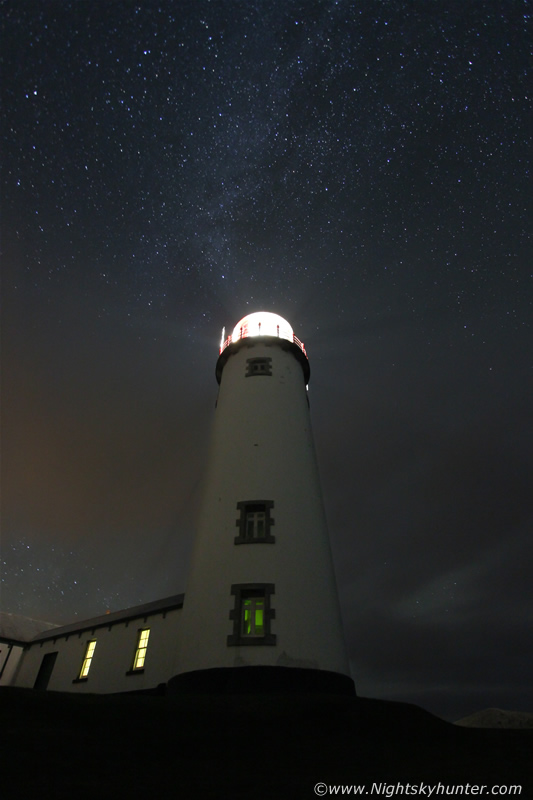 |
Later in the night doing a rare portrait exposure with the MW between Cygnus and Cepheus above the lighthouse. Paul yelled across the gentle breeze, just one word - ''aurora'' - we met up with him to check it out. There were clouds low on the N and NW horizon but Paul had spotted a gap and using his high ISO and faster lens he was able to detect the aurora as a green glow above the horizon perhaps 10 degrees high then a follow up exposure showed red above the green, classic aurora activity and although weak and nothing dramatic it was still cool to pick up from this location on our very first night here. Paul was getting truly awesome images using his full frame Canon 6D with Samyang 14mm F/2.8 lens, the high ISO-low noise images he was capturing were stunning and the MW seemed to be jumping out from the screen, a truly impressive camera indeed.
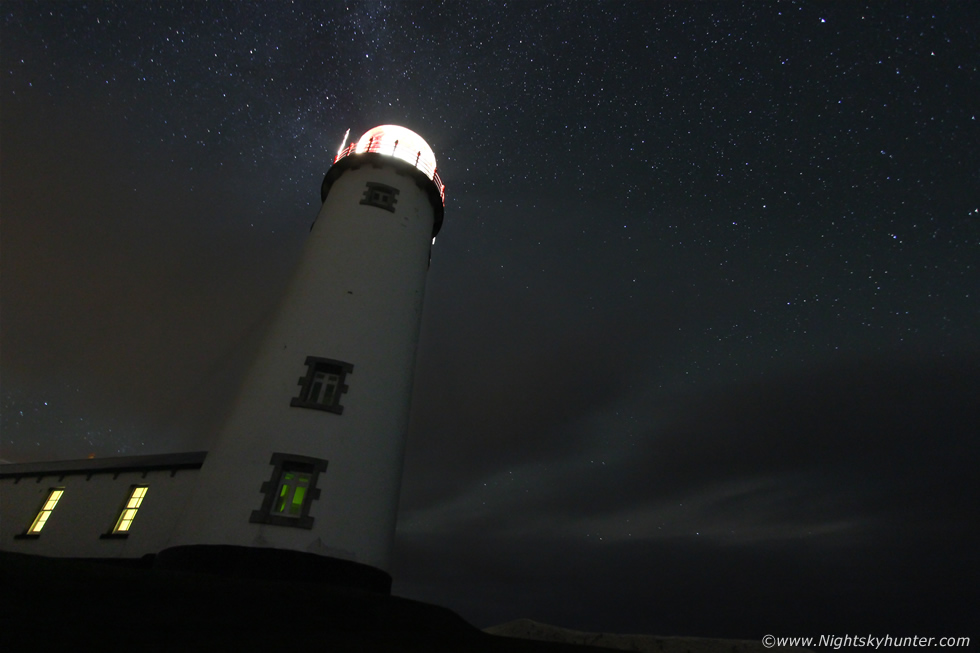 |
Atmospheric scene with dark clouds, stars and subtle airglow with beams of light sweeping across the stars and clouds, I have to admit it felt epic being this close to a large lighthouse under a night sky like this from a remote location with the sea gently rumbling against the rocks far below.
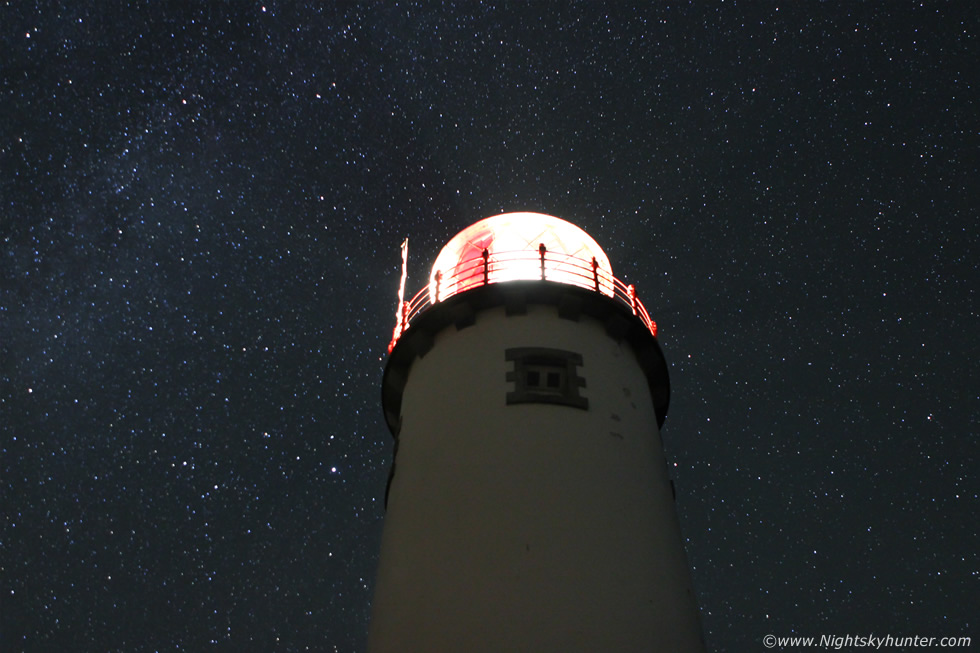 |
At 02.00 the sky was at its absolute finest and was simply astounding with not a cloud in sight, I was sure I had gained a full magnitude with the naked eye at this time and I imagined what it would be like to have a great comet on view on a night like this, I fantasized about the sight of Donati's comet with its huge sweeping dust tail or the great comet of 1910 which frightened the populace, what a sight celestial phantoms like these would have been from such an awesome location as this, I hope that at some stage in the not to distant future a great comet will be discovered with significant tail at a far elongation from the sun like Hale-Bobb was in 1997, and if that happens I would like to be here to photograph it along side this majestic lighthouse. I was now using the Canon 24-70mm F/2.8 lens to get closer to the tower with the MW between Lyra and Cygnus on show.
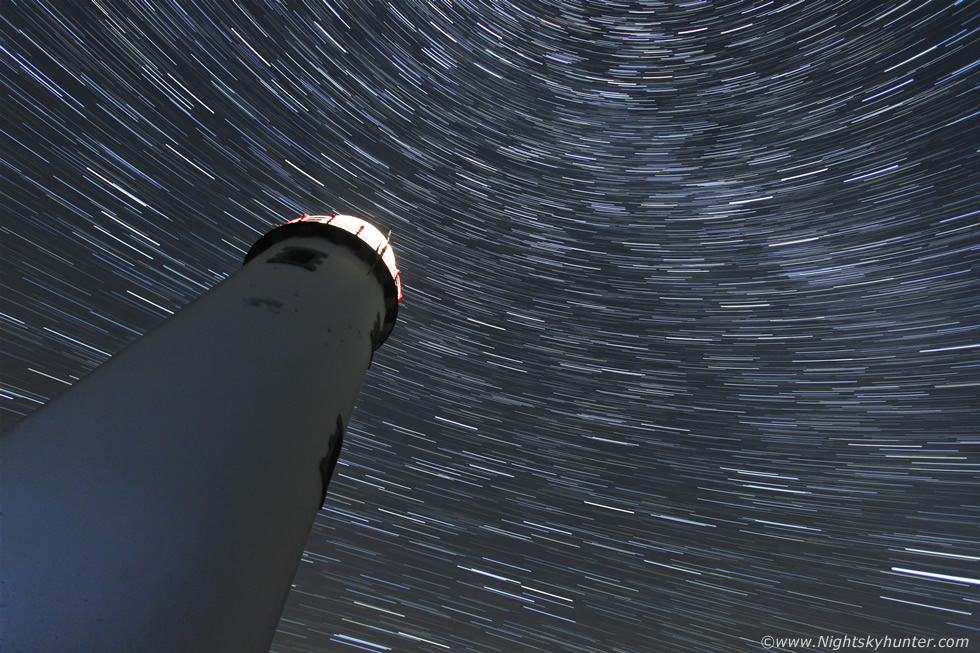 |
I couldn't believe our luck with the clear sky so I did a second star trail, this time looking straight up the tower at 10mm, ISO1600, 41 x 30 sec's or 20.5 min's. You can almost feel the rotation of the Earth here, I'm getting dizzy!
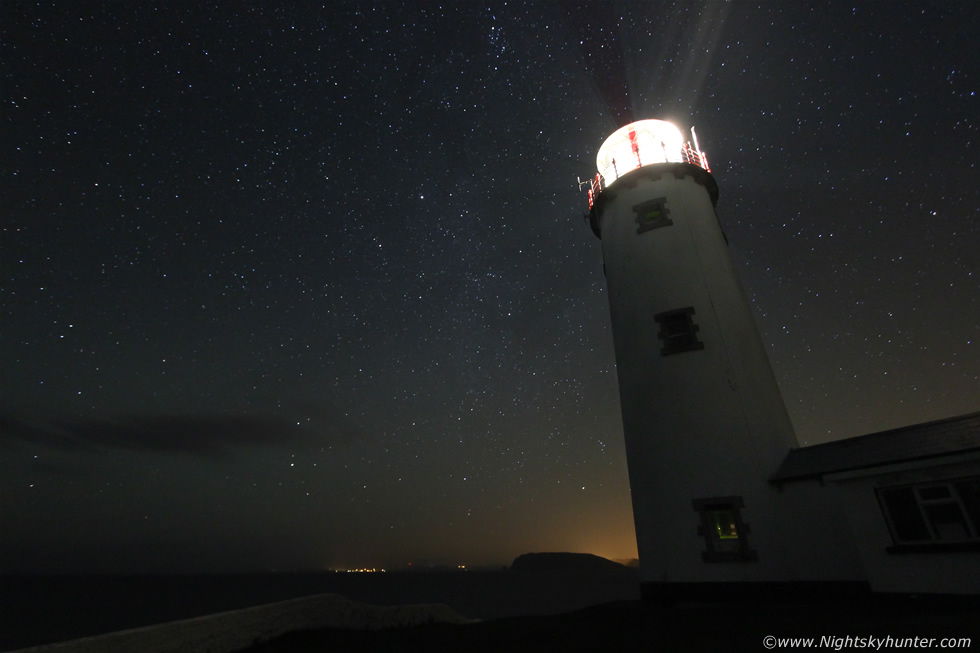 |
Airglow, lighthouse and stars, it felt surreal being here and so refreshing and vitalizing being at a new location. Tiredness was beginning to creep up on us all, none of us had any dinner and a long day and it was starting to take its tole, then a cool breeze picked up increasing the wind chill and although it was pleasant it began to affect us with time. Roisin was getting cold and tired and wanted to warm up in the van so I set up my camera for the last star trail of the night, there was no chance of the lens dewing over with the breeze and I liked this angle so I let it run while Roisin and I made our way back while Paul continued shooting and observing around the corner.
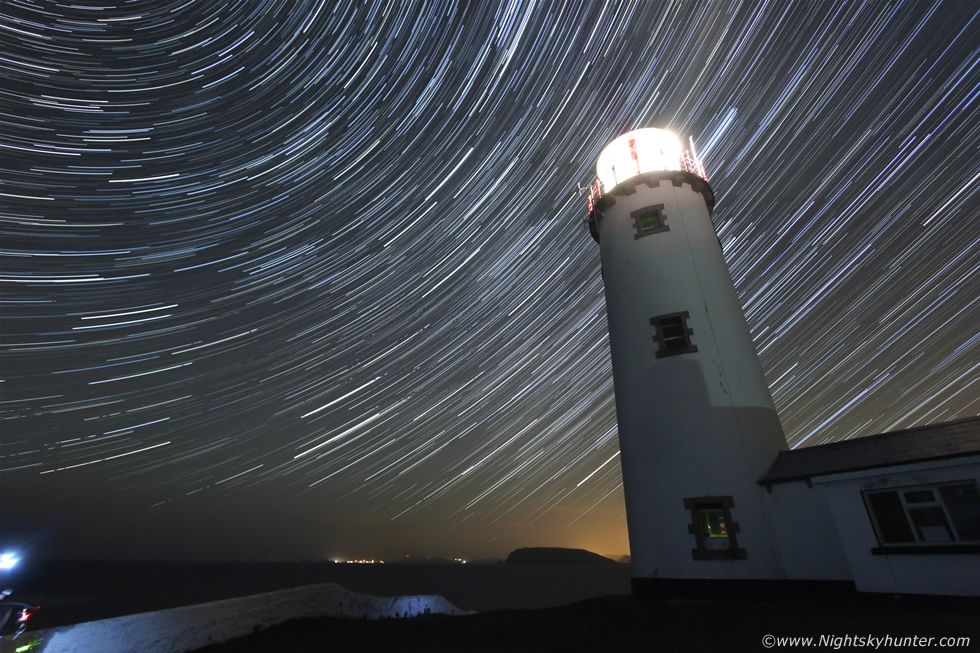 |
I stayed with Roisin while she warmed up in the car then walked back to the lighthouse on my own to end the exposures. The result was my longest star trail of the night and one which I'm very happy with, this was 10mm, ISO1600, 86 x 30 sec's for 43 min's of actual time, you can see Paul's blue head torch at the edge of frame.
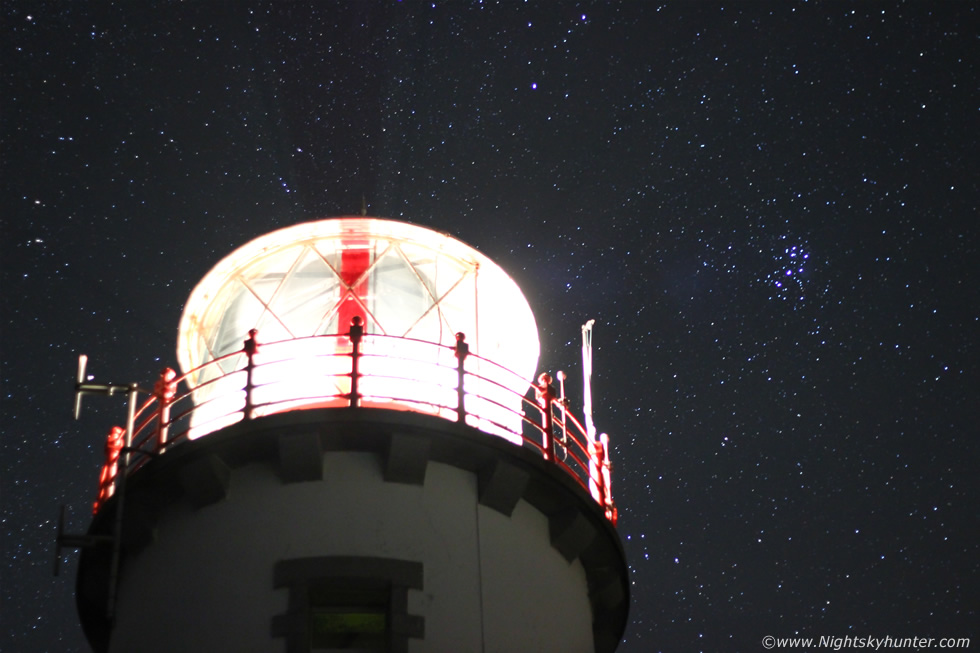 |
Before packing away the gear I had one last shot to end the night. This was up close to the lighthouse tower using the 50mm F/1.8 lens stopped down to F/2.4 with the Pleiades Cluster or 'Seven Sisters' visible to to the right sporting a gorgeous blue colour due to the fact that they are hot young stars. A lighthouse kepper with cap and pipe leaning against the rails would have really made this scene!. We made our way back to the Berlingo then began the long drive home. We made it to Maghera by 04.30 after 4 hrs on the road and 180 miles covered yet Paul had another good 45 min's to 1 hr of driving back to Omagh then I spent until after 05.30 building these three star trails while in bed then finally got to sleep around 06.00. I fell into a happy sleep that night with visions in my mind of the pulsing lighthouse and the glowing MW while the ocean rumbled below taking me by the hand to sleepsville.
Short video clip featuring the star trail images and time lapse segments, these are the actual still frames which make up the complete star trail, however using the same software you can compile time lapse movies as well as trails which is another great bonus, these are simply short clips however you can see the potential. Thanks very much for reading.
Martin McKenna